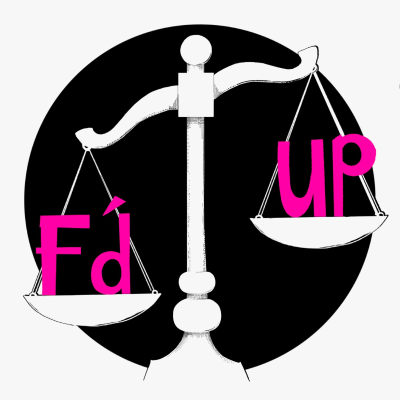
F'd Up
Podcast de Priya Hubbard & Jessica Borges
Priya Hubbard and Jessica Borges invite their friend Keith over for rosé to tell him about their in-depth investigation of one of the biggest crime lab scandals of the century.
Empieza 7 días de prueba
$99.00 / mes después de la prueba.Cancela cuando quieras.
Todos los episodios
14 episodiosThe F’d Up Finale Recap Written by Brandi Abbott On F’d Up this season we’ve learned a lot about how broken the criminal justice system is and how fucked up the NC SBI Crime Lab has been. There has been some reform based on everything that has come to light, but there is still a long way to go. After Alan Gell’s case in 2004, the governor signed a bill that required DAs to provide all of their files from their cases to defense attorneys if they ask for them. The attorney general at the time, Roy Cooper, made changes to the SBI Crime Lab. He installed an ombudsman to address concerns relating to the crime lab or its employees. Documents and ASCLD-LAB reports were posted for transparency, but none of the results or repercussions from internal investigations seem to have been made public. The governor at the time, Pat McCrory, moved the SBI Crime Lab from under the purview of the attorney general at the time, Roy Cooper, to the department of justice so that it was under the purview of the governor and the name was changed from the NC SBI Crime Lab to the NC State Crime Lab. In 2016, Roy Cooper ran for governor and narrowly beat Pat McCrory, which put the crime lab back under his control. Right after the audit report was released, the governor at that time, Bev Perdue, signed a bill making it a crime for lab workers to withhold results. The North Carolina SBI Blood Stain Pattern Analysis unit was suspended during the audit. To this day it has still not been reopened and analysis of bloodstain patterns is outsourced. When Priya and Jess went into detail about the history and missions of the crime lab in NC, they didn’t mention that all of the information was from the current crime lab’s website. According to their site they and other forensic labs across the nation are now subject to the ISO/ISE 17025 accreditation standard. ANAB is authorized to perform this accreditation but no one can confirm whether or not they’re the one’s doing the accreditation for the NC State Crime Lab. One would hope not given that ANAB merged with ASCLD LAB who spent years accrediting the SBI Crime lab while it was full of misconduct. Priya checked out some public documents on the state crime lab’s site and found an update on the preservation of biological evidence. They now preserve evidence in capital cases until the convicted person is executed or dies and if a convicted person receives a life sentence, the evidence is preserved until they die. But if a person pleads guilty in a crime – evidence is only preserved for three years! Three years doesn’t seem like very long given how often coercion of confessions occur. Priya says that she’s visited the site often over the course of doing research for this podcast, and that recently a lot of information that used to be easy to access like policies, accreditation reports and the like are not as easy to obtain. Policies can only be accessed if you sign in with a Microsoft account and you have to email the lab to get accreditation reports. Another reform is the forensic advisory board that is now in place and includes forensic scientists from a couple of different states, however, they could benefit from a commission like the one Marvin Schechter is on in New York that includes more people who are involved in the justice system or are impacted by forensic science, like defense attorneys. Their website includes the minutes from their board meetings up until a year ago, but if they’re still meeting, they don’t seem to update the site any longer. The new director of the lab, Vanessa Martinucci, does have a forensic background which is a big deal considering their past employees. She has a Masters in biology and was a supervisor at the Houston Forensic Science Center. People Priya and Jess have talked to who were or are affected by the lab has said a lot of this hasn’t helped to fix the huge systemic issues that have happened. Instead, it seems as though they’re making changes to distract from their issues. People had been trying to enact change in North Carolina even before Greg Taylor’s exoneration. Chief Justice I. Beverly Lake had been noticing problematic issues in NC cases, the same kind Chris Mumma was noticing when she was clerking for him. Because of these concerns, in 2002 Chief Justice Lake established the Criminal Justice Study Commission, the purpose of which was to review police and prosecution procedures for factors that helped lead to wrongful convictions. This commission helped to birth the Innocence Inquiry Commission - which ultimately led to Greg Taylor’s exoneration. In very sad news, Chief Justice died last month, but he leaves a legacy of trying to make the world a better place. Chief Justice Lake, along with Darryl Hunt and others, helped in getting the Racial Justice Act enacted in 2009. As you may recall from an earlier episode, the Racial Justice Act allowed death row inmates and those still on trial to challenge their sentence if they thought it had been negatively impacted by their race. They also discussed that in December of 2012, three defendants who had been on death row had their cases reheard because of this act and their lives were saved. F’d Up covered three cases on the past episode but there was actually six. As you may remember from that episode, the three that were discussed had their sentences reduced to life in prison and this was only possible because they filed their grievances prior to 2013 when then governor Pat McCrory signed a repeal of the Racial Justice Act. This repeal affected all of the cases. One of these cases was Tilmon Golphin, a black man, was pursued by the police through the woods where they eventually caught him. A perspective juror who was black overheard two white jurors say that Tillman never should have made it out of the woods. The black juror brought this up and the prosecutor questioned him about it. He was struck from the jury but the two white people were not. Overall, five of the seven qualified black people were removed from the jury. Tilmon was ultimately sentenced by a jury of 11 white people and one black person. This was in Johnston county which had billboards boasting that it was “KKK country” up until the 80s. Another case was Rayford Burke who was black and was sentenced to death by an all white jury. The prosecutor drew attention to Rayford’s size and race in a negative fashion and called him a “big black bull” during a plea for the jury to find him guilty. Quintel Augustine is also black. In his case, the prosecutor wrote handwritten notes about each perspective juror. For a perspective white juror who admitted to drinking, they wrote “drinks, country boy, okay” but described a perspective black juror who admitted to drinking as a black wino. For a black female juror they made the note that she was from a “respectable black family” but made no such note for any of the white jurors about their potential “respectable” families. In the case of Marcus Robinson there was a perspective juror who was black and a high school graduate. The prosecutor asked this juror if he repeated grades or had trouble reading, but never asked any of the prospective white jurors the same question. This prosecutor admitted he was not particularly racially fair. Christina Walter’s trial involved the prosecutor asking prospective jurors if they ever felt they had been burgled. Two white perspective jurors who had had some minor property crimes and felt it wasn’t a big deal ended up on the jury, whereas a black prospective juror was struck when they said they didn’t feel like a victim over their car being broken into and a radio stolen. Out of 14 qualified black jurors, 10 ended up being struck. Cassandra Stubbs, the director of the ACLU Capital Punishment Project, said that one of the things that was so remarkable about the Racial Justice Act was that before when one suspected prosecutors were acting discriminatory, there was no opportunity to question them. With the RJA they had to testify about and answer to their actions. As of August of 2019, the RJA is back on the table. The state Supreme Court heard all six cases that fell under the RJA. A couple of choices were on the table. Do the four defendants try and get back life without parole or do they try and get new hearings since it’s already been proven that there was racial bias in their cases. According to the NCCADP, for the other two cases the court will decide whether people on death row who filed claims under the RJA will get their chance to present their evidence in court even after the repeal. They went on to say that three of the six defendants were sentenced to death under an all white jury. The NCCADP breaks down a study done in Michigan that was covered in the death row episode to say that qualified black jurors were struck from capital juries at twice the rate as white jurors. Even when other factors are brought in, the disparity can only be attributed to race. Defendants found direct evidence of discrimination such as prosecutors’ notes of potential jurors where the notes included descriptions such as “blk wino” and “thug”. Cassandra Stubbs is the director of the ACLU Capital Punishment Project and represents one of the defendants, Marcus Robinson. She spoke with a reporter at the Real News Network and said that even though the NC Supreme Court didn’t re-sentence them to death and did not enter a new order about their life sentences, after they remanded, all four prisoners were moved from the prisons around the state where they had been serving their life without parole sentences. Without any reason at all, these four defendants were moved back to death row. If the court rules in the defendants favor, they can get new hearings and present significant evidence that race played a factor in their sentencing. The RJA attorneys said that the states highest court must take on this crucial issue and if it doesn’t, it will send the message that the state is willing to execute people after overwhelming evidence of racism in their trial has come to light. Cassandra said never before had any state sanctioned dismissal of comparable allegations and proof of racial bias. The state’s position is that since the RJA has been repealed we should all just forget about everything and move on, but the court cannot. Attorneys for the NC Attorney General’s office did not dispute the evidence of racism and said that racism in capital trials is serious and must be dealt with. However they asked the courts to deny the cases and leave the lower courts to deal with it, though they haven’t been doing a great job so far. As of right now, the courts have not ruled and it’s unclear when that’s expected to happen. The New York Times Editorial Board wrote an article about the RJA, which showed that the actions of the prosecutors in these capital cases were unconstitutional. The practice of being able to strike black jurors from cases with impunity was banned by the Supreme Court in 1986 after a case named Batson v. Kentucky. However, just because the Supreme Court banned the practice, it doesn’t mean prosecutors stopped doing it, just that they tried to hide it better. The article said that especially in places like North Carolina, this wasn’t the behavior of a few bad apples, it was standard operating procedure. There was a document distributed to NC prosecutors in training that apparently listed 10 “race neutral” explanations for striking a juror in case a judge asked. Categories included inappropriate dress, physical appearance, attitude, body language, and hair. If this is too subtle for you, the document was titled “Batson Justifications Articulating Juror Negatives”. This is especially important as prosecutors receive no repercussions for their actions, except under the RJA. As mentioned earlier, in August of this year attorneys from across the state argued before the state Supreme Court on behalf of the six individuals who are on death row and filed claims under the Racial Justice Act. Cassandra told a reporter for the NCCADP that everyone who filed a RJA case is entitled to a hearing on their RJA claims. This was because of a case decided after the Civil War called “Keith”, which is the best name! Cassandra said in the case of Keith, a war criminal who massacred boys and men ages 13-60 was given amnesty by the NC Supreme Court because of due process. He was given a defense by the NC Legislature. A few years later the NC Legislature came in and repealed that act, and he successfully invoked the defense that was given to him by them. The Supreme Court ruled that he was entitled to it, and a repeal could not take it away. So essentially, the question is will a law that protected confederate soldiers and has never been overturned protect these cases. When the court eventually rules on all of this, according to the NCCADP, the outcome could affect nearly 150 other prisoners who petitioned under the RJA but never got their day in court. Lawyers for the prisoners who filed claims said the law may now be gone but they still should have a chance to prove that their client’s punishment was racially motivated. There’s a group of former judges, prosecutors, and law enforcement officials who have a hope that the court will use this as an opportunity to strike down punishment in NC all together. A series of articles written by Radley Balko, he sought solutions from experts who work in the areas of law and forensics. Radley wrote that the legal system is too reluctant to revisit cases. As Priya has mentioned before, she’s of the opinion that retesting old cases with updated science is her idealistic solution to so many issues. Money is a huge obstacle with this but I would bet there are those who don’t want even more of their mistakes to come to light. Within the past 10 years there have been attempts to correct some of the issues with forensic science. In 2013, Congress and the Obama administration created the National Commission on Forensic Science, a panel of lawyers and scientists whose job it was to come up with standards and protocols in this field. However the Trump administration allowed the commissions’ charter to expire in April of 2017 - which is unsurprising since he doesn’t even believe in science. Radley found in speaking with his experts that the one resounding answer for reform has been what has come up again and again that all forensic labs should become independent of police and prosecutors. However, according to the experts Priya and Jess have spoken with, police and prosecutors don’t want to give up their “aces up their sleeves” especially as they are provided with little to no cost. Radley found that people he reached out to agree that if we keep this current system, then defense attorneys should be given the same amount of funds to provide their own experts. Forensic pathologist Judy Melinek told him that local pubic defender offices need to be funded at the same level as prosecutor’s and need to be given the same amount of access to forensic evidence. She also suggested that the laws should be changed to where defendants can appeal their convictions if scientific advancements indicate that they were wrongfully convicted based on faulty scientific testimony. Radley discussed the fact that many fields of forensics have come under scrutiny in recent years such as blood stain pattern analysis, hair fiber analysis, ballistics testing, and fingerprint analysis. Eyewitness testing has also been shown to be much less reliable than most people think and juries give them too much consideration. Bloodstain pattern analysis has been criticized as being more subjective than scientific. Steps have been made in the right direction using something called “fluid dynamics and physics”. Sandra Guerra Thompson, a law professor and the director of the Criminal Justice Institute at the University of Houston Law Center is a founding member of the board of directors of the Houston Forensic Science Center. The crime lab in Houston was once affiliated with the police and underwent a huge scandal similar to the North Carolina SBI Crime Lab. However, the response from their scandal was for the crime lab to be replaced with the Houston Forensic Center which is an independent lab. Texas has also created an influential science commission that in 2016, rendered bite mark evidence, a type of junk science, inadmissible. Sandra told Radley that the more information an analyst gets from law enforcement officials, the more likely they are to produce a false positive. Good scientists know that cognitive bias is a threat and take precautions to keep it from corrupting their work. Many of Radley’s experts suggested the idea of a case manager to benefit labs. As analysts receive information such as race, a case manager, who would preferably have a scientific background could be the go between for analysts and law enforcement and would decide what information needs to be distributed to the analyst. Barbara A. Spellman, a professor of law, and former professor of psychology from the University of Virginia suggests that for every case of which there is forensic evidence could have three forensic evidence who would examine the evidence together. By lottery one would be the consultant to the plaintiff, one to the defendant, and one would testify at the trial. Radley mentioned that a few of his experts cited the Houston Forensic Science Center as the ideal model of an independent science driven crime lab. That lab has already implemented the case managers and the shield analysts from being able to expend any bias. Sandra suggests that labs should be transparent and all documents including accreditation and even budget reports should be posted on the website and easy to find. She also suggested independent labs across the board, not just for eliminating bias, but also because she’s learned that independence enables labs are able to be transparent without needing approval from law enforcement and they eliminate the appearance of pro-police bias. She says that having scientists (who are not affiliated with police) collect the evidence from crime scenes restores the public’s trust, especially in officer-involved shootings. Another of Radley’s experts is Fred Whitehurst who Priya spoke with about his personal experiences in the FBI Forensic Lab. He was the whistleblower in a scandal there and ultimately turned his experience into an organization to help whistleblowers. Whistleblowers should be protected so that they’ll be more comfortable coming forwards. ASCLD-LAB had reporting protocols that involved using your own name and handwriting your complaint so that it essentially discouraged anyone from coming forward and “tattling”. Fred and a gentleman named John Lentini, another one of Radley’s experts in fire and arson – they were in complete agreement: suggesting that analysts be held accountable if their expert opinions led to a wrongful conviction. John also suggested that prosecutors be held accountable for intentional Brady violations - which is where prosecutors are required to hand over any and all evidence that could potentially exonerate the defendant. John told Radley he wants the court to reverse the Connick v. Thompson decision so that prosecutors will be held accountable for these violations. As John Lentini told Radley, and perhaps this answers some of the questions about Brady violations. Priya said she’s all for prosecutors being held liable for their wrongdoings, but she had no idea what the Connick v. Thompson decision was, so she looked it up: apparently the Connick in this is Harry Connick Sr. - the father of Harry Connick Jr. And the Thompson in this case was John Thompson who, in the 80s, was charged - with another guy - for killing someone. And in this case, a fucking lot of fuckery happened.Including Connick allegedly withholding evidence that blood that was not the victim’s was found on or around the body - and that blood did not match John’s blood. John was innocent.John sued and won $14 million dollars a million for each year he was wrongfully imprisoned. But, you know, no one liked that - and nothing Priya read suggests this, but my theory is that John was a black man in Louisiana who was a shining example of a bunch of white prosecutors fucking up. So, his win was appealed. The case went all the way to the Supreme Court. And despite popular opinion that there were an awful lot of shenanigans in that case, the Supreme Court ruled in Harry Connick Sr.’s favor, and, well, prosecutors can legally withhold Brady materials. Obviously, Queen Ruth Bader Ginsburg dissented in this case. Because of course she did. Prosecutors are almost immune when it comes to wrongdoing. They’re immune to civil cases and are rarely disciplined in cases of misconduct. An article written in March of 2019 looking into accountability for prosecutors in California, mentions that the CA State Bar rarely investigates prosecutors. They mention that a lack of resources may contribute to this. They looked at a study that found in California from 2004-2009 there were 707 instances where a judge found that a prosecutor committed misconduct. Only six of those resulted in a public sanction by the state bar. This problem isn’t isolated to California: in Massachusetts only two prosecutors were publicly disciplined between 1980 and 2016. There were at least 142 instances during that same period of time where a judge reversed a guilty verdict or dismissed charges due to prosecutor misconduct. Over 1,400 non-prosecutors have been disciplined in Massachusetts over the last 15 years. In Louisiana, the first professional sanction against a prosecutor didn’t occur until 2005. New York Governor Andrew Cuomo approved a bill in the spring of 2019 to set up the nations first independent commission to investigate reports of misconduct by prosecutors. The bill received support from many black and latinx democrats who saw it as an answer to systemic racism. The commission will be made up of 11 people who can investigate attorneys and determine whether their conduct is unprofessional or unlawful. Prosecutors have been fighting this and calling it unconstitutional, even filing suit against it. The article discusses the different types of unethical stuff prosecutors do and mentions that they have a “whatever it takes mentality”. The article also notes that when someone is accused of a crime they cease to be seen as a person by the legal system. It says that without plea bargaining our criminal system couldn’t process the nearly 11 million arrests that occur every year, and without misconduct way fewer people would plead guilty. We live in a culture that doesn’t trust defense lawyers. Marvin Schechter told Priya that people often ask him how he can defend guilty people to which he replies “how can I not defend innocent people?” Our system promises innocent until proven guilty but that doesn’t seem to be the case. The defense attorneys fight for that promise, but exonerees are left with broken promises from the system. They’re presumed guilty from the beginning and often are even after being exonerated. They deserve a public apology and the victims deserve a promise that the justice system will do everything they can to find the person actually responsible for the crime. Priya and Jess asked their experts if they had a “wis hlist” of reforms they would like to see. On Chris Mumma’s list was restrictions or controls on the use of jailhouse informants. In many of the cases this podcast has covered, jailhouse informants were used and were lying. The I Beverly Lake Jr Fair Trial Act was put up for a vote. It included concerns about the reliability of jailhouse informants and suggested that no one should be convicted based on the word of a jailhouse informant alone, there should be other corroborated evidence. Regulating the use of jailhouse informants should be done nationwide and Connecticut is currently doing work in this area. The new rules there include requiring pre-trial hearings on whether their testimony should be allowed and forcing prosecutors to disclose any deals with informants and their history of testifying in other cases. A bill was signed in July that will create the nation’s first statewide system to track the use of informants and the benefits they receive in exchange for their testimony. California, Connecticut, Oklahoma, and Utah all require juries to be given instructions to scrutinize informant’s testimonies. Also on Chris’ wish list was a more cooperative post-conviction review and resolution process and repercussions for prosecutorial misconduct. This item was on a few of their expert’s list. Kim Cook’s and Saundra Westervelt’s list includes that the state helps an exoneree readjust to life after exoneration. They suggest reparations for the exonerated person and their family, compensation within a reasonable about of time, expungement of the crimes for which they were convicted immediately upon release, access to healthcare including mental healthcare, free education and training for employment, assistance finding employment, and adjustments to social security, they also want officials and advocates to remember the harm done to the victims or family of victims at the heart of the original conviction case. They suggest reparations that may assist in their healing in the form of: time to ask questions about how this happened, answers to be provided by the judicial body overturning the conviction or someone in a position of authority who does not continue to maintain the exoneree’s guilt, an opportunity to meet the exonerated person if both parties agree, financial compensation to help with costs from the wrongful conviction, access to healthcare to assist with physical or emotional trauma, and extension of the statute of limitations for rape and sexual assault cases to allow the identification of the actual perpetrator. Priya goes a step further and says that the evidence should be preserved for a long time. This is especially true as it’s not always easy for survivors to come forward. Marilyn Miller said she would like to see the adoption of common sense standards set by The Organization of Scientific Area Committees for Forensic Science (OSAC). The standards they set include minimum requirements, best practices, standard protocols, and other guidance to help ensure the results of the forensic analysis are reliable and reproducible. She would also like to see the accreditation of forensic science programs in higher education. Marilyn was also asked about some of the things she was grateful for. The standards set by OSAC is one of those as well as lawyers who understand the power of forensic science done properly and 25 years of cool students. The impact of the results of the audit will be felt for a long time as prosecutors and defense attorneys examine cases up to two decades old. Chris Mumma is still dealing with the reverberations today. In episode two we learned that the Center on Actual Innocence rejects 95% of the cases that come across their desk as they have to pass a series of rigorous tests. When Chris takes on a case, it means not only that there’s credible evidence that the individual is innocent but it seems to mean the individual is definitely innocent. When she takes on a case she completely dedicates herself to the case. Chris had been dealing with the SBI Crime Lab since 2006 and is still dealing with the repercussions of their misconduct. On May 5th 2008, a boater on the Catawba River in Mt Holly, NC called 911 after seeing a car that had run off an embankment and a body near it. When police arrived, they discovered the body of Ira Yarmolenko, a 20 year old UNC Charlotte student, lying dead next to her car. She had three ligatures around her neck and 100 yards down the embankment a man named Mark Carver and his cousin Neal Cassada were fishing. DNA found microscopic skin cells that “matched” Mark in Ira’s car. This is touch DNA which is really unreliable because it’s something you could leave just by picking something up in the store. Mark and Neil were charged with the murder of Ira and ultimately placed under house arrest. Being charged with a murder you didn’t commit sounds like it would be extremely stressful, so it’s not that big of a surprise that the night before his trial, Neil had a heart attack and died. Prosecutors offered Mark a deal where he would get four to eight years in prison, and, as he was innocent, he turned down their offer and the case went to trial. Like we’ve seen before, the defense thought the case was really weak and didn’t bother to provide any evidence. At this point, it was 2011 and the 230 cases from the audit had happened but that was evidently not enough for the defense attorneys to be diligent. A year earlier there had been a publication of updated guidelines that were relevant to the evidence reported at the trial. Had the DNA testing been reported at the trial, none of it would have been reported as matching Mark but instead he was sentenced to life in prison. Chris Mumma took on Mark’s case in 2013 and after a number of delays, the hearing began last spring. On April 8th, 2019, former SBI Special Agent Mark Booty testified. He said that in the lab in 2010 everyone was panicked about the audit report that had just come out but inexplicably inside the lab, agents were ignoring scientific advancements that could have helped Mark. He told the court that they were trying to save their jobs and that they weren’t focused on science at the time. A couple of years prior to the trial, Chris Mumma pointed out the similarities between Mark and Greg’s cases where the biggest reason for the conviction was proximity to a dead body. Priya says that, on a personal note, it was great watching the headlines over the summer because in June the judge set aside Mark’s case and he walked out of the courtroom a free man. However, he still has an ankle monitor and was not found not guilty. Mark will likely have to suffer through a new trial, but maybe justice will prevail and the charges will be dropped. Of course this means that after a decade, there has been no investigation into who actually murdered Ira. Mark and Neal have always been the only suspects so it’s likely that, as with Greg, there won’t be any investigation, meaning there will be no justice for the victim and her friends and family. There are many similarities between Greg and Mark’s cases including the minuscule evidence and offers of plea deals. Chris refers to Mark as her “Greg Taylor 2.0”. It was Greg’s case that sounded the alarm that something was drastically wrong in the SBI lab, which plunged the lab into chaos. The chaos that resulted in no one paying attention to the evidence that could have cleared Mark and his cousin. Chris says that it’s almost ironic that the exoneration of one of her clients could have lead to the wrongful conviction of another. In Radley Balko’s articles that were referenced earlier, Judy Melenik suggested that if the courts are following the laws placed before them by legislatures then it’s time to find legislatures who are serious about criminal justice reform and who are ready to pass laws that fund forensic labs and require the legal system to give the wrongfully convicted another chance at overturning those convictions and seeking retribution. Jess and Priya advises us that DAs are elected officials and that the best thing we can do is "vote the F’d Up people out”. To close the podcast, the F’d Up crew share their final thoughts on what they’ve covered this season. Keith says that in doing this podcast he’s been most surprised about the justice system’s willingness to pick and choose evidence to which Priya says that they don’t treat someone as innocent until proving guilty. It’s more like they decide the person is guilty and just work towards proving it. When asked what reform she would like to see since doing this podcast, Jess said for her it’s that the prosecutors are held accountable. Priya says that that’s also a huge deal for her and that behind the scenes of doing the podcast she’s learned that you have to be very clear in asking for a lawyer. You can’t say something like “I may want a lawyer now” you have to clearly invoke your right for a lawyer, and she wants more people to know that. In closing they want us to know the most important thing we can do to help is vote.
Acronyms are F’d Up P. 2 Recap Written by Brandi Abbott Continuing from where the last episode left off, George Goode - who was sentenced to death after being convicted of murder - was thankfully granted an additional hearing in 2004. Judge Jenkins, who had filed the complaint against Attorney Diane Savage, recused himself, and Goode’s case was heard by a new judge. Diane obtained the SBI lab notes which revealed that the alleged blood on George’s coveralls was actually grease. Not blood. The case file didn’t include a confirmatory test of the “invisible” blood on George’s boots. DNA testing revealed that profiles were obtained, but it was most likely due to a transfer. All of the evidence from George’s case was crammed together in a bin, including the bloody tailgate from the victim’s truck and the clothes worn by George’s brother and friend which were covered in the victims’ blood. An article from the Winston-Salem Journal stated that DNA testing wasn’t part of the original case against Goode and that, before the hearing, the state asked to have George’s coveralls, which had tested negative for blood in 1992, retested. This time, blood from both of the victims was found, most likely because they had been in a bin with other objects covered in the victims’ blood. People in the scientific community were shocked by this mishandling of evidence. Some said they might have tested George’s coveralls or boots but would have done control tests and reported the likelihood of contamination. The SBI Crime Lab did not run control tests. They had one of their fiber experts examine the coveralls with a microscope. He concluded that the stains were blood that had soaked into the garment at the time of the crime, but he never used chemicals to confirm that the substance he was examining was actually blood. The deputy director of the SBI’s Crime Lab at that time, William Weis, told the Winston-Salem Journal that what another lab would do in a case described to them may be completely different than what they would do, as the SBI Crime Lab are looking at the evidence and the others are not. He said he believed they should rely on the evidence presented in court. The issue with that way of thinking, is the confirmatory tests were not included in the evidence presented, therefore the evidence presented in court is misrepresented. You may remember from the last episode, Deaver said he hadn’t done a confirmatory test on George’s shoes, which was suspicious and out of character for him. At the trial, he referred twice to the “blood” he found as if he were sure that’s what he had found, and during the hearing, the DA said that they had proved George was “literally up to his ankles in the blood of both victims.” Diane rhetorically asked The Journal how a prosecutor could say someone is up to their ankles in blood if there was never a test for blood. She was extremely upset about everything happening, and she and other attorneys lodged complaints with ASCLD LAB. Complaints to ASCLD LAB in 2011 needed to be submitted in writing. All complaints of labs were to be directed to their executive director, Ralph Keaton, and receipts of the complaint would be confirmed within 20 days. However according to Marvin Schechter, the New York attorney Priya spoke with, there was no procedure for follow up with these complaints. The complaint ends with an ASCLD LAB board vote. If 2/3 of the vote can’t be reached, the case is dismissed, and the complainant must be notified. On October 5th, 2004, Diane sent a few letters of complaint about the SBI to Ralph Keaton. She’d called and had a conversation with him and was directed to put her complaints in writing. She wrote one letter detailing everything about George Goode’s case and in another letter mentions that the phenolphthalein test used out of date chemicals. She then wrote about Brenda Bissette’s testimony. Bissette swore under oath that she’d had no knowledge of how the evidence had been stored, but Diane showed Brenda photos of her standing directly next to the evidence in the bin, and she corrected her testimony on the witness stand. This was not the first case Marilyn Miller had encountered Bissette co-mingling evidence on. In the evidence for George’s case, there was a pair of pants with blood in different areas. The cuttings from each area were all packed together in one evidence bag, leaving great potential for cross contamination. This should have rendered the cuttings inadmissible. Diane wrote in her complaint that SBI Crime Lab Deputy Director Jerry Richardson stated that he knew nothing of the condition of the evidence’s packaging, that it was Bissette’s responsibility, and admitted that Bissette saw the evidence before it went to the lab. In 2009, a judge reprimanded SBI Blood Stain Pattern Analyst, Duane Deaver, for misleading the jury in George’s case by referring to the substance on George’s clothes as blood as if it were fact. After the audit in 2010, Diane wanted a new trial for George, especially since he had been mentioned in the audit. George was not given a new trial but was given a resentencing hearing where it was determined he’d had ineffective council in the original hearing. His sentence was reduced from death to life in prison. All of the money wasted by an innocent man being on death row for 20 years could have been spent a multitude of ways that would actually help the community. They could have even used it to retest old evidence with the newer science that’s become available since the initial trial. George Goode, with no evidence linking him to the murders, is still in prison to this day. There was no national database that kept track of labs that incurred infractions or were involved in scandals. Various newspapers had reported on 50 labs, 28 of which where ASCLD LAB accredited. Marvin Schechter’s memo cites 11 states where their lab failures encompass different forms: there were mistakes in the identification of fibers, destroyed blood samples, DNA contamination, failure to perform maintenance and calibration, mix up of key physical evidence, faking calibration dates, false credentials, and many more. Marvin cites the NC SBI Crime Lab as one of the worst in terms of failures. ASCLD LAB accredited that lab five times during the time all of these errors were being made. After the audit was released, ASCLD LAB issued statements basically amounting to “that was then, this is now,” which seems to be what we keep hearing. They also appointed a new president, although it’s unclear if it was related to the audit. The new president said that the confirmatory results that proved substances weren’t blood “weren’t hidden” and that they were “in the notes.” Oh sure. In the notes where no one could see them except the shady lab techs, definitely qualifies as “not hidden.” ASCLD LAB flat-out rejected that lab reports issued by forensic serologists were inaccurate, misleading, intended to hide information, and essentially chose to ignore the findings of the audit. Ignoring and finding no issue with all of the shoddy practices done by the SBI Lab only enables the potential for all of this to happen again. For the resentencing hearing in George’s case, Diane was working with an attorney named Bill Garrens. Bill had a special interest in this case because he had had his eye on Deaver since around 1989 when there was a murder case that Bill had been the defense attorney on. When interviewed for this podcast, Bill said the case was a brutal beating with a baseball bat to the victim’s head, and his client claimed he was a bystander. Deaver had been at the SBI Crime Lab for about four years at this time, and he knew he needed to do a reconstruction of the crime scene. Deaver went to a gymnasium, put up a sheet, put down something similar to parchment paper, put pumpkins on the parchment paper, grabbed a bat and “went to town.” Bill raised concerns about the science behind smashing pumpkins in 1989 and the judge agreed with him, refusing to show Deaver’s recreation in court. Two things to be noted are that concerns with Deaver had been brought up as early as 1989 and that Bill, as a male attorney who was not a Yankee, was allowed to criticize Deaver with no repercussions, while Diane faced disbarment when she did it. Also, according to the News and Observer, the reason it was ruled that George had had ineffective council, was because his attorney had not raised concerns about Deaver… the very thing Diane had been punished for doing. In the last episode, it was said that the executive director for ASCLD LAB, Ralph Keaton, wanted the headquarters to be in North Carolina because he lived there. Well, prior to joining ASCLD LAB, he was the assistant crime lab director of the NC SBI Crime Lab until 1995. In fact, he wasn’t the only former-SBI Crime Lab employee: there were two others, John Neuner and Michael Creasey. Keaton stated that they recused themselves from matters related to the NC SBI Crime Lab. However, every article Priya has read has comments from Keaton on the SBI lab. The News and Observer reported that around the time the audit was released or about to be released, he said that he didn’t think there was a large number of cases that had a miscarriage of justice and that the absence of evidence isn’t evidence of innocence. Neuner defended ASCLD LAB by saying they had suspended labs and put labs on probation, but he couldn’t say which ones because they don’t keep up with it. Neuner’s predecessor attributed the infrequency of suspensions or dismissals to the fact that labs accredited by ASCLD LAB are simply of “high quality.” This seems pretty unlikely, considering all of the mistakes coming out of the SBI Crime Lab, and how closely the staff of both ACLD LAB and the SBI Crime Lab commingled. In 2007, the serology unit was in trouble due to testing proficiency and was moved out from under the oversight of ASCLD LAB. Priya says that she’s of the opinion that Keaton and his cronies recommended that the SBI Crime Lab get the serology unity away from oversight. She implies it was a “real bro culture” out there and that judges protect DAs and analysts. That everyone was buddies who help each other out, leaving defense attorneys as the only people who are looking out for their client. If ASCLD LAB isn’t putting in proper procedures to make sure that the labs are operating as they should: in a manner designed to help carry out justice, it’s no surprise that injustices have happened. Jess says that it seems like ASCLD LAB was designed to prevent injustices but instead was perpetuating them. Ralph Keaton was the one to encourage Duane Deaver to start teaching classes at the SBI Crime Lab. So basically, the executive director of the accrediting body for the SBI Lab was responsible for getting their most public purveyor of fuckups started. Priya says one thing she’s noticed in all of her research is that Deaver was always by the book. He lied and cheated, but in a manner that was approved of by the SBI. There were two times he actively straight up lied. Once was in 2009 before the panel in Greg Taylor’s case. He claimed he hadn’t thoroughly reviewed the file and hadn’t lied on purpose. There’s credible evidence to support this as he approached one of the DA’s after the hearing and said that a confirmatory test had been done and it was negative. He was the person who let people know it was there. Priya’s conspiracy theory is that Deaver lied in 1997 at George Goode’s appeal when Diane asked about the confirmatory test and he said he didn’t do one. She says that in all of research she’s done on him and interviews and trials she’s watched or read, she’s noticed that he doesn’t tend to remember many of the cases he’s been involved with. The two he brings up regularly are Greg Taylor’s and George Goode’s. He often brings up George’s case, including in a 2013 deposition when he was fighting to get his job back. This case really sticks out to him and not doing a confirmatory test was really out of character. Priya thinks that even though withholding the results of confirmatory tests was sanctioned at this time, Deaver knew it was wrong. She thinks he did a confirmatory test, that he knew the results, they were in his written notes and that he guessed that Diane was going to ask about it. She thinks he brought this up to his superiors and was scared. She points out that around this time, a superior had ordered a lab tech to destroy evidence in Daniel Green’s case, and that it wouldn’t be a leap to think the SBI lab would be freaked out at the idea of a defense attorney asking for the results of that test - especially since 10 years later, people still didn’t know that they even did confirmatory tests. Priya thinks that the confirmatory test was done and the record of it was destroyed. As F’d Up has mentioned before, the practices in the SBI Lab were originally unwritten policy. Deaver’s superior sent out a memo saying if an initial test for blood and saliva was positive but confirmatory tests were not, they should say that evidence showed chemical evidence for their presence. And this is when this kind of reporting became written policy. Priya says she believes that the SBI Crime Lab covered up Deaver’s lie and made an entire policy to “really drill it home,” because they always looked out for their guys and themselves. Next episode is the finale and F’d Up will be exploring reforms, recommendations for change and one last F'd Up case.
Acronyms are F’d Up Pt. 1 Recap Written by Brandi Abbott In 1992, George Goode was at his home with his brother Chris and friend Eugene DeCastro. The landlord, Leon Batton, came by for rent and a verbal fight broke out outside between Chris, Eugene, and Leon. George was still in his trailer. The argument escalated really quickly - to the point that Chris and Eugene attacked Leon physically and ultimately stabbed him to death. Leon’s wife, Margaret, got a call that someone was attacking her husband and she rushed over – Chris and Eugene turned their attention to her and inexplicably killed this poor woman as well. George who had remained inside for the entire altercation was in shock and terrified but Chris and Eugene snapped him out of it and all three men fled. For whatever reason, Chris handed Leon’s wallet to George at some point - so evidently they had robbed him as well. George was arrested very quickly, shortly followed by his brother, and Eugene the next day. As they had no time to pop home and take a shower or anything, Chris and Eugene were still covered in blood when they were picked up. George had absolutely no blood on him; and the SBI Crime Lab at the time even verified this, but a knife was found near where he was arrested and he had Leon’s wallet and somehow he was charged with murder. George’s trial began in 1993 when Duane Deaver was a young up and comer, and he testified at the trial that there was “invisible blood” on George’s boots. No one asked if this was his initial test or confirmatory test, because at that time, no one knew to ask. No one asked about the coveralls George was wearing which had been tested by a different analyst and received negative results because the defense didn’t have access to the files. George and Eugene were sentenced to the death penalty, whereas Chris received life in prison, but as he was actually covered in blood, we aren’t sure why he received a lighter sentence. Diane Savage, who has been mentioned a few times so far in the podcast, was born and raised in New York and a bit of a troublemaker. She was kicked out of her family home at a very young age, but she was scrappy and got a job in a lab to provide for herself. After a few years of working there, the lab workers decided to unionize and she helped them. She also helped with community organizing. Stuff like this was what she really enjoyed and wanted to continue helping others. She decided law school was the way to go, and got in to Georgetown. During her time in Washington D.C., she met her now husband who received a job opportunity in North Carolina, so they relocated. When she first arrived in NC, she was told by a local that she had “three marks against her”. 1. That she was a Yankee, 2. That she went to a fancy school and, 3. That she was a woman. Diane’s first case as an attorney in North Carolina was George’s appeal. As we learned in the last episode, if you’re sentenced to death row, you’re appointed two defense attorneys. He got Diane and Lisa Williams. As Diane was reading through the case file, she noticed that there wasn’t a record of confirmatory tests. She had hired forensic expert, Marilyn Miller, and also had her lab background – and both women found the lack of secondary tests concerning. Note: This case was Marilyn’s first experience with Deaver and his shitty science. Phenolphthalein was the presumptive test that was used to confirm the alleged blood on George’s clothes. At the trial Diane questioned Deaver about his confirmatory tests, which were standard operating procedure in the SBI lab (even if reporting them was not), and Deaver claimed he didn’t do one. As evidenced throughout the podcast and in the Audit report, he always did a confirmatory test - so this was weird. The judge in this case didn’t like that Diane Savage was “living up to her last name”, according to Priya, and the DA didn’t like the way she was treating Deaver. According to Diane, Judge Jenkins told her that she engaged in character assassination and maligned elected public officials. He also told her that if she were correct about Duane Deaver, a grand jury should be convened and people prosecuted for perjury. Diane said that the judge struck the pleading over what she said about Deaver and she would have to start over again. He also took what’s called judicial notice to basically declare as “fact” that Duane Deaver was great. To further prove his point, he reported Diane to the state bar for discipline. She was investigated and removed from her cases.Thankfully, she was ultimately cleared of any wrongdoing. Priya pointed out that this was in 1997 and if people had listened to Diane then, they may have been able to shave 13 years off of a lot of people’s sentences and maybe even saved some lives (see: Death Row is F’d Up). ASCLD LAB was the only agency that had accredited the SBI Crime Lab as of 2010, and as the News and Observer stated, had missed all of the problems. They should have been aware of all of the mess the SBI had been concocting and should have stopped it. ASCLD LAB stands for The American Society of Crime Lab Directors Laboratory Accreditation Board, is not to be confused with ASCLD which is just the American Society of Crime Lab Directors. Confused yet? I sure am. As F’d Up has discussed, the NCSBI Crime Lab is closely intertwined with prosecutors and ASCLD LAB is much the same. ASCLD LAB HQ was located in Johnston County, NC - which was in close proximity to the executive director’s home. In 2016, ASCLD LAB joined forces with an organization named ANAB, which stands for ANSI-ASQ National Accreditation Board. The hidden acronym in that one stands for American National Standards Institute- American Society for Quality. If your acronym is so long, it needs its own acronym, you have a problem. After the merger, ASCLD LABS and ANAB became just ANAB. When ASCLD was formed in 1974, their early goals were to address a quality control for labs and their practices, and it was decided that accreditation was the way to go. As ASCLD was not an accrediting body, ASCLD LABS was formed in 1982. Labs accredited by ASCLD LAB must be up to their standards and willing to be re-inspected on site every five years. The process for accreditation includes a tech or supervisor selecting at least five cases for review, which basically means the lab can pick whichever cases they want to be reviewed - and would obviously select their best cases. If a lab is found to be non-compliant, they have the opportunity to correct the issue. At some point after the audit, Chris Swecker told the News and Observer that it was thought that ASCLD LAB was infallible and it was surprising to him that they hadn’t gotten a better sense of what was going on in the SBI Crime Lab for all of those years. It was surprising to only him however, as the labs always knew that ASCLD LAB was coming for a review and were allowed to cherry-pick cases. According to a few articles, the SBI has repeatedly had to fix policies or correct cases in order to pass, but they always did pass and remain in good standing with ASCLD LAB. ASCLD LAB is quoted as saying that they often bend over backwards to help labs pass because they want them to pass. A defense lawyer Priya spoke with, who is part of the New York State Commission of Forensic Science, named Marvin Schechter wrote in a memo in 2011 that ASCLD LAB could more accurately be described as a product service organization that sells a seal of approval for a fee. This is something labs can use to bolster their credibility. Marvin Schechter was in his office in New York when he got a call from a friend in D.C. that a commission was being formed to identify needs from forensic science. They wanted a well-rounded committee of lawyers, scientists, and judges with different perspectives of the needs of forensic science. They were missing a defensive attorney and Marvin’s friend recommended him. With this commission, he coauthored the National Academy of Science’s 2009 report titled “Strengthening Forensic Science in the United States: A Path Forward”. This report was a 350-page look at forensic science that identified the needs of the forensic science world and made recommendations to the forensic science community. One thing that the report didn’t look at was accrediting entities for forensic labs in the countries. People like Marvin began getting concerned about these entities, such as ASCLD LABS, because they seemed to have no concern about the blatant wrongdoing in the labs. He wrote a memo to the New York State Commission in March of 2011 that was a detailed analysis about ASCLD LAB and forensic laboratory accreditation which is what inspired Priya to reach out to him for F’d Up. What she learned from speaking to him was that around the same time as the audit and everything going on in NC after Greg Taylor’s exoneration, the SFPDCL (San Francisco Police Department Crime Lab) were garnering attention. A tech in the drug testing area had been stealing cocaine from the lab for personal use, and in May of 2010, the drug testing section was shut down. A whistleblower sent a letter in 2008 to a public defender and a letter in 2009 to ASCLD LAB revealing that there had been a DNA test tube mess-up by a tech that was covered up by a supervisor. In July of 2009, ASCLD LAB sent a letter to that supervisor who denied knowing anything about it. After investigating, verifying that there was a mixup, and finding out the files had been destroyed in an attempted cover-up, ASCLD LAB accredited that lab for another five years. In 2009, the NYSIG (New York State Inspector General), issued a report that mentioned the SDPDCL and its issues. It also mentioned a tech in the NYSPFIC (New York State Police Forensic Investigation Center) had fabricated fiber analysis evidence which occurred while the lab was being accredited by ASCLD LAB. A guy named Jay Jarvis who was on the ASCLD LAB board of directors, referred to this report in an article he had written, meaning they were aware of these issues. The gist of the excuses thrown around over these fuckups is that it’s “one guy in one lab”, but it’s not. There’s a pattern of, at minimum, gross negligence and at most, intentional lying. Duane Deaver is usually named in relation to the disaster that is the SBI Crime Lab and their audit, but as we’ve learned, he wasn’t the only one fucking up, just the one most often blamed. As you may remember, the NAS report in 2009 recommended that lab employees have a science background in biology or chemistry. And… Peter Duane Deaver graduated from North Carolina University with a degree in zoology in 1984. On December 1st, 1985, Deaver was hired by the SBI to work in the serology section of the SBI Crime Lab. Deaver attended the SBI Academy in March of 1986 and worked his first serology case in 1988. At that time a man named Mark Nelson was in charged of the serology department. In 2010, Deaver was involved with 50 of the 230 cases in the audit. When the audit was released, he was suspended with pay and advised that he was the subject of an administrative investigation. In January 2011, he was officially fired. One reason behind this was that he was asked to look over some evidence during his suspension in October of 2010 which was sanctioned by the SBI, but in late October, without permission, he assisted a criminal profiler with writing a complaint related to the case. He asked for his name to be taken off of this complaint as he wasn’t suppose to be working on it while on leave, but removing his name wasn’t legal. Another reason was on September 3rd of 2009, Deaver told the IIC that there was no further testing in Greg Taylor’s case, but there had been. The last reason was his unprofessionalism in saying “that’s a wrap baby” at the end of the video where Gerald Thomas was trying to “shore up” evidence in Kirk Turner’s case. About a month after being fired, he met with SBI Director McLeod in an attempt to get his job back but was denied. He appealed his firing and the case went before the State Human Resources Committee. He claimed that he didn’t perjure himself at trial because he rushed through the file quickly in the car right before the hearing. He defended his performance in the video by claiming he didn’t know the sound would be on in the video. He presented the video he did with Suzi Barker in the Peterson case where she jumps up and down and pointed out that she was only reprimanded, whereas he was he fired. Essentially, everything Deaver had done was being done by everyone in the SBI Crime Lab. His lawyer brought up the fact that Deaver was the scapegoat for the SBI. Getting rid of him was a way to put the public’s mind at ease. The State Human Resources Commission came to the conclusion that the lesser disciplinary action of being demoted with a reduction in his salary would have been appropriate for Deaver. They noted, however, that on July 16th, 2013 Deaver was found to have presented false or misleading evidence for the Michael Peterson case and that would have been grounds for firing. Deaver was unfired in November of 2014 and reinstated into his previous position with two years of backpay and “all of the other benefits of continuous state employment”. He was fired again the same day he was unfired with a backdate of July 16th, 2013 which was the day his misconduct in the Michael Peterson case came to light. Meanwhile, Suzi Barker is still employed with the SBI and Gerald Thomas has climbed the ladder to almost the top of the SBI. Essentially, as F’d Up has been saying this whole time, Duane Deaver isn’t the only problem, there are problems in labs all across America. Next week’s episode will delve more into those, more acronyms, the rest of George Goode’s case, and some tinfoil hat theories about Duane Deaver.
Death Row is F’d Up Recap Written by Brandi Abbott A truck driver named Allen Ray Jenkins was found murdered in his home on April 14th 1995. He had been shot at close range with his own shotgun. Two teenage girls admitted to being in his home at the time of his murder and claimed that a man named James Alan Gell, who goes by Alan, was the murderer. The SBI Special Agent Dwight Ransom and the Chief of Police locked on to Alan pretty immediately. Witness claimed to have seen Jenkins alive after the 3rd of April, but the police needed him to have been killed on the third for reasons that will be covered in a bit, so they pretty much coerced the witnesses into changing their statements to say they were unsure of when they last saw him alive. The police arrested Alan on August 1st 1995, and he was charged with first-degree murder, conspiracy to commit murder, armed robbery, and conspiracy to commit robbery. The girls testified at his trial saying that he had committed the murder, and Alan was convicted and sentenced to the death penalty. Because Alan wasn’t well off financially and had received the death penalty, the state had to supply him with two public defenders. Also, a law was enacted where they had to be supplied with the entire case file, whereas that wasn’t true for pre-convictions. Defense attorneys James Comey and Mary Pollard began working Alan’s case in 2002 and found the original witness statements wherein the witnesses said they had seen Jenkins alive after April 3rd which raised a lot of red flags. They brought in Marilyn Miller to help with this case and she went to the crime scene and examined the evidence and photographs from the crime scene. The bloodstain patterns were initially analyzed by an SBI Special Agent named Dennis Honeycut who was NOT a bloodstain pattern analyst. If he had been trained in bloodstained pattern analysis, like Marilyn, he would have been able to tell that the blood stain patterns did not match up with the girls’ story about where Alan and Jenkins had been standing. They changed their story six different times, getting closer and closer to what the police needed each time. The attorneys also called a professor of entomology who was able to determine that based on the maggots in Jenkins’ body, he died on April 8th, 9th, or 10th, but definitely not April 3rd. The reason the April 3rd date was so important to the investigators was because Alan had ironclad alibis for the 4th ‘til when Jenkins’ body was found. In 2002, Alan’s conviction was vacated and he had to be retried in the murder of Alan Ray Jenkins. Alan’s defense team at the retrial included Mary and James, but also Joe Cheshire and Brad Bannon who were Kirk Turner’s defense attorneys. After another two years, Alan was acquitted of all charges on February 18th, 2004. The death penalty has been around at least since 18th century BC. King Hammurabi had about 25 different crimes that were punishable by death, and 5th century BC Rome would carry out the death penalty by crucifixion, drowning, beating, burning alive, or impalement. England in 16th century AD incorporated more methods including hangings, beheadings, burning at the stake, and drawing and quartering. Crimes punishable by death included: treason, not confessing to a crime, and more. The first known execution in North Carolina was a Native American man in 1726, likely in the form of a public hanging. Public hangings were treated more like a party than an execution and entire families would travel to attend, possibly with a small feast prepared. By 1910, the State of NC took charge of executions, whereas before, they were handled locally. There seemed to be a need for consistency and a more humane method, so the state decided that the electric chair would be less painful than hangings, and then in the 1930s replaced the electric chair with the gas chamber. In 1972, the US Supreme Court ruled the death penalty as cruel and unusual punishment and ruled that the jury would be able to use their discretion when imposing the death penalty. North Carolina enacted a law in response that certain crimes would be mandatory for certain crimes - which led to 120 condemned inmates. Four years after that, the US Supreme Court overturned the mandatory death penalty laws and those 120 condemned inmates had their sentences vacated, commuted, or were re-sentenced to life in prison. By 1977 in NC, the death penalty was reintroduced for first-degree murder. The 80s and 90s were a time recognized as “tough on crime” across the entire US and harsher punishments were handed out more freely. Between the years of 1984 and 2006, 43 people were executed in North Carolina. On October 29th, 1988, North Carolina officially made lethal injection the soul method of execution. Alan Gell’s removal from death row and ultimate acquittal warranted a review of how death penalty cases were pursued by law enforcement. They should have taken the death penalty off of the table until they could review what happened in Alan’s case. There have been nine people acquitted from death row in North Carolina, and the chances are high there are still innocent people on death row in that state today. In 2003, Senator Eleanor Kinnaird proposed a bill to create a two year study on capital sentencing along the economic, geographical, and racial lines but the bill didn’t make it past the NC House of Representatives. On August 18th, 2006, Samuel Flippen was the last person to be executed in North Carolina, and since then there has been a hiatus on executions in the state for various reasons. In 2014, a Wake County Superior Court Judge named Donald Stevens blocked the use of lethal injection in the state, finding that method to be cruel and unusual. This means that people who are still on death row in North Carolina, most of which have been there since the 90s, get to spend every day wondering whether or not the state will eventually kill them. Alan Gell spent nine years in prison for a murder he didn’t commit, six of which were spent on death row. F’d Up wanted to try and understand what those six years looked like. They went to the website of The Department of Safety to see how they describe death row. According to the website, there are two facilities, one for men and one for women and each one provides a day room. Inmates can spend their time in the day room or their cells, all of which are all single cells. Each cell includes a bed, a sink, a toilet, and a wall mounted writing desk. The day room includes tables, a TV, and showers at the end of it. Two days a week inmates can go for a supervised jog or play basketball. All in all, sounding like a summer camp so far. The website warns, that if a death row inmate violates prison regulations, they may be placed in a cell block segregated from death row. However, a report by the ACLU “Called a Death Before Dying” reports that inmates are locked in their cells for 22-24 hours a day with little human contact, lack of natural light, and severe constraints on visitation. The Center on Death Penalty Litigation is a non-profit organization that provides legal representation to death row inmates. Gretchen Engle, their executive director who’s been with the center since 1992, described being on death row as a harsher punishment than serving a life sentence. She told NC’s public radio that work and education opportunities are limited, inmates can only talk to lawyers or loved ones on the phone or through protective glass, and that it’s more isolating for women as there are only three there. Inmates spend their days waiting for their sentences to be reduced or to be executed. All of this can have extremely adverse affects on mental and physical health and there are very few resources provided to combat these affects. Death Row is populated with living breathing human beings, a lot of which committed the same or similar crimes as people who are NOT on death row. Advocates for the death penalty claim that it’s an effective deterrent for heinous crimes - which is untrue. It’s also used as a bargaining tool by law enforcement and prosecutors. The death penalty as a bargaining tool was examined in a study, which says that because prosecutors have the ability to determine how someone is charged, they often choose first-degree murder as it allows for the death penalty, Apparently, all a prosecutor has to do is go before a judge and show that there are aggravating factors present. The study reveals that people who have spent months in jail under the possibility of being tried capitally, are more likely to plead guilty in hopes to avoid the death penalty. The study states that while death sentences have decreased in North Carolina, capital charges have not. Also according to the study, there has been at least one wrongful capital prosecution in North Carolina every year since 1987. This study showed that prosecutors are charging the maximum penalty for negotiating in their weakest cases. Prosecutors also have complete immunity from misconduct and face no repercussions or accountability. The study learned that the state spent nearly 2.4 million dollars in defense costs to pursue these failed capital cases. Since 2006, 16 convicted murderers have been sent to a death row that isn’t executing people. The state had made some reforms and recognized the impact of mental illness, coerced confessions, and incompetent public defenders. Death Row supporters, however, are critical of the delays and want the executions to happen. Some are obviously eager for the state to begin killing human beings again. Ken Honeycutt is a former prosecutor who use to celebrate new death row convictions by gifting his assistant prosecutors with lapel pins shaped like nooses. Friendships are developed by people on death row, as these people are who you spend your days with, and you have a big thing in common: You’re facing certain death. Alan Gell formed a close friendship with a man named Desmond Keith Carter. Alan believed that Desmond’s case warranted another look and begged his attorneys to help his buddy when Alan was taken off of death row. This was before the SBI Crime Lab audit, and while Alan’s case was not listed on there, Desmond’s was. Duane Deaver had been the analyst in Desmond’s case, and according to the audit, his testing confirmed the presence of blood despite a negative result. Desmond confessed to the crime. It’s completely possible that Desmond’s confession was coerced using this blood “evidence”, but it’s also possible that it wasn’t, as there’s no way to know for sure. Desmond’s attorneys weren’t experienced in capital cases. Priya says she personally believes Alan’s assessment of the situation and that Desmond’s case deserves to be looked into. She says that if we depend on jailhouse informants for negative testimonies, why can’t we depend on them for positive testimonies as well? There were a lot of people who believed in the importance of getting Desmond off death row including the National Coalition to Abolish the Death Penalty who wrote a public plea for his life that examined his upbringing and substance abuse. Desmond may have been self medicating due to coming from a broken home, and became addicted to alcohol and drugs. His grandmother tried to get him help, but he was rejected due to lack of health insurance. A couple of weeks after this is when he may have ended up in his alleged victims home, though it’s unclear if there is evidence linking him to the victim. On that day he had been drinking, smoking crack, and using tranquilizers, and allegedly went to the victims home seeking money for more drugs. The plea for his life says the death penalty won’t stop the cycle of violence linked to poverty and oppression because it fails to address the roots of the crisis. Desmond also didn’t have the money for an attorney and was appointed one named Doug Hux who had previously reprimanded by the state bar. The plea states that capital defenders are the ones most often reprimanded. The ACLU published a fact sheet called “Race and the Death Penalty” that said that impoverished people who go through the death penalty are regularly represented by ineffective council who are underpaid and overworked which affects people of color the most. The plea references a 2001 study conducted by the University of North Carolina that illustrates the racial divide between both the race of the defendants and the race of the victims. Of the people on death row, 82% of them had cases involving white victims. Race also comes into play with sentencing. Desmond was a black man who was convicted of killing a white woman. Black people represent about 20% of people in North Carolina, but there are 78 black people on death row, 52 white people, and others who are Native American or identified as “other”. The numbers are disproportionate and do not mean that black people commit more crimes, what they mean is that the system is broken and needs to be fixed. Priya says that one step towards that is unbiased science. People started seeing the giant problem with racial bias in the criminal justice system, and with the help of Darryl Hunt, the Racial Justice Act was enacted in August of 2009 that allowed death row inmates to challenge their sentence if they believed it was impacted by racial bias. This also covered people being currently tried. They can show evidence demonstrating that race was a factor in their case during sentencing. This can be done in three ways: evidence that the death penalty was sought or imposed more frequently in the case of one race more than others, evidence that the death penalty was sought or imposed more frequently on behalf of victims of one race more than others, or evidence that race was a significant factor in decisions to exercise peremptory strikes during jury selection. You may have thought that if you were tried it would be by a jury of your peers, however the 6th amendment only refers to a person getting an impartial jury, but nothing about them being your peers. White men used to be the only people allowed to serve on juries – it’s still kind of that way today. In 2010, two associates professors of law at Michigan State University did a study on racial bias in jury selection in North Carolina. They looked at a number of factors in the jury selection progress and found that prosecutors excused eligible black members as jurors at a significantly higher rate than other races and that this was even higher in cases involving black defendants. At that time in North Carolina, of the 160 people on death row, 31 of them had all white juries at their sentencing and 38 had predominately white. North Carolina is one of the few states who don’t pay their jurors for jury duty. Some employers allow you to use sick time or vacation time, but that’s not always an option. Judges will often excuse a person from jury duty if it’s going to be a significant financial burden, but often those that are excused are people of color in poverty. These are usually the people that a defendant needs on their jury, and this could be fixed by the judged ordering employers to pay or it becoming federal law to do so. In December of 2012, three defendants successively appealed their sentences under the Racial Justice Act and got their sentences reduced to life without parole. The case was appealed by the state and was overturned, but in 2018, the case was appealed again and their sentences were reduced again. When their cases were heard in 2018, they were reheard retroactively because some white Republicans worked to rewrite, then successfully repeal, the Racial Justice Act. One of the seven people listed in the audit that had been sentenced to death row, Patricia Jennings, was resentenced after the report was released and moved from death row to general population after 23 years. All of the usual things an exonerate experiences like continued PTSD, reintegration, depression, struggling with loss of relationships etc… are experienced by a death row exoneree and more. Kim and Saundra spoke with an exoneree who lived with the fear of being strapped in and killed every single day who didn’t want to put his seatbelt on his lawyer’s car because of the trauma associated with being strapped in. Another person Kim and Saundra spoke with compared their experience to an open wound because they never stop hurting and another said they struggle with detachment even seven years after his release. There’s a dehumanization to being placed on death row - Alan Gell says society has to perceive them as monsters because to perceive them as human beings, it wouldn’t be acceptable to execute them. He says “you have to take the humanity away for the death penalty to be okay.” The effort to dehumanize can start during the investigation and might be seen during sentencing. A man named Greg Wilhoit told Kim and Saundra that during his sentencing the judge said “We will kill you by lethal injection, and if that fails we’ll kill you by electrocution. If the power goes out, we will hang you. If the rope breaks, we will take you out back and shoot you.” For a person on death row, there are additional issues that a person in prison may not face. There’s a survivors’ guilt when the people they’ve made friends with get taken away for their execution, or if they’re exonerated for leaving people behind on death row. Prior to his release, Alan Gell struggled with disillusionment when his lawyer discovered evidence that would eventually exonerate him. A video of one of the teenage girls talking to her boyfriend about the story she was going to fabricate was never given to Alan’s initial defense attorney. On top of this was the witness statements and altered witness statements and the whole time, he’s struggling to understand why none of this was brought up at his trial. Alan was happy when he got out but then was slapped with the reality if it all and wanted to know where the evidence had gone. He said that he believed for years that the girls manipulated the system and the system didn’t know any better. He said he still found it discouraging that he was the 113th mistake. The 113th person exonerated from death row. Once he was free, he had a hard time with women because of the circumstances that got him on death row. He thought he may be betrayed again. However, he reconnected with an old girlfriend after getting out of prison. Jess says perhaps it was easier to trust her because he knew her before and that she was the same woman he had been dating when he cheated on her with one of the two teenagers who accused him of murder. They reconnected and fell in love and got married. Prior to the wedding she joked that he better not cheat on her again because “remember what happened last time” which is super dark but Jess says probably is the type of humor they can share. The couple recently had a baby. Priya found an execution procedure manual from the North Carolina Central Prison where men on death row reside. The first step is setting an official date, then the order of the execution, then a week before the execution the prisoner is placed on deathwatch status. One to three days before the execution, the condemned prisoner is transferred to the deathwatch area -where they are closely monitored by an officer. The “execution team members” include a licensed physician, two registered nurses, two paramedics, and seven correctional custody personnel - who the manual describes as executioners. These people are all hired by the warden and must possess a willingness to participate and be of sound mind. There are rehearsals of the execution process around every other month or so. The condemned prisoner will have to have a medical personal identify veins and potential problems with access to them. There are two groups of syringes on hand, one to be used as a backup if the first group doesn’t work. The prisoner will be placed on a gurney and a roll of gauze will be placed into each of the prisoner’s hands - which are then taped to prevent them from trying to stop the execution. The condemned prisoner can give last words after all of the IVs are in place and the warden will call the Secretary of Public Safety to make sure there have been no changes. Post-execution the body will be transferred to the medical examiner’s office who will establish cause of death and arrange for transportation to a funeral home if that’s what the next of kin wants or it will be disposed of by law. Immediately after the execution, the warden will hold a post-execution debriefing with the execution team members to discuss how it went. Priya says that at no point in the manual did she see anything about mental health care for the people who participated in the execution. She says there’s no way that participating in taking another human life wouldn’t have adverse affects. That even in the off chance that they are okay with it and know in their hearts that the person committed an awful crime and feels like they deserve this, what happens if they find out the person was innocent down the road? How would they feel if they had put Alan Gell to death or any of the other death row exonerees? There were seven people listed in the audit who were on death row or already executed. John Hardy Rose was one of these people and was executed on November 30th, 2001, nine years prior to the audit. A man named Joseph Timothy Keel was executed seven years prior to the audit on November 7th, 2003. Joseph’s attorney was interviewed about his client being on the list and said that that was the problem with the death penalty, that there were no do-overs and that they can’t go back and fix these errors. Patricia Jennings was mentioned earlier in the episode. There’s not a lot known about the remaining names on the report but their presence on it, almost certainly means that true justice wasn’t served. Their names were John Robert Elliott, Terry Lee Ball, and Chris Roseborro. Priya says she would call these seven cases resulting from the SBI’s crimes attempted murder, and three of them, actual murder. Desmond Keith Carter was scheduled to be executed on the day that Alan’s case was vacated. He had begged his lawyers to help Desmond, but at that point there was nothing they could do. On December 10th, 2002, Desmond Keith Carter was executed. The fuckery in the SBI Crime Lab resulted in those deaths and more as there are others on the list who died in prison. How did this lab get away for this as long as they did? The scope of the audit was limited to 1987-2003. That was 16 years wherein 230 cases where found, seven of which were death row cases. This is a lot for a crime lab who were accredited by ASCLD LAB. F’d Up will get into them and more on the next episode.
The Cost is F’d Up Part Two Recap Written by Brandi Abbott On August 10th, 1984 the body of a woman who had been sexually assaulted and stabbed to death was found. A witness stated that he had seen the victim with a black man named Darryl Hunt the morning before she had been murdered. Another witness claimed they had seen her with another man who couldn’t have done it but then changed their statement to say they had seen her with Darryl after being pressed by the police. Darryl’s girlfriend was arrested for outstanding charges against her, but was most likely arrested so the police could get more information on Darryl. She told them that he had confessed to her that he had murdered the victim. Darryl maintained his innocence, but was tried for first degree murder. Many of the witnesses testified that he had either been seen with the victim or covered in blood, but he testified that he didn’t even know the victim. He was convicted and sentenced to life in prison. It’s possible that his jury was completely white but there are conflicting reports. One holdout on the jury prevented him from being sentenced to death. When Darryl was convicted, the black community was upset to say the least. The black community thought he was innocent, whereas the white community thought he was guilty. The case was extremely racially charged, even in prison because the victim was a young successful white woman. Darryl told Larry that he was a target for the skinheads. After five years in prison, Darryl’s conviction was overturned because it was revealed that the prosecutors presented Darryl’s ex-girlfriend’s statement, which she had recanted even before the trial. He was released on bond while he awaited a new trial and was offered a plea deal that if he just pled guilty he could have time served and not spend another day in prison. As he was innocent, he refused. Darryl was retried in front of all of all-white jury and, as well as the original witnesses, some jailhouse informants showed up to testify. Darryl was convicted for a second time and sentenced to life in prison. During all of this, the SBI had compiled a report that was thousands of pages long, but the trial court opted to not review it and the judge ordered it sealed so that no one would be able to read it. All requests from Darryl’s attorneys, Mark Rabil and Ben Dowling-Sendor, to get the report unsealed were denied. The attorneys requested DNA testing on a semen sample found on the victim because Ben found out that the SBI had more evidence than they were saying, including this sample. Prior to this, the SBI complained that the sample was too degraded to test. Darryl’s attorneys argued that there was witness tampering and evidence that the SBI was clearly concealing. The judge disagreed that there was anything shady going on, but allowed for testing of the semen sample. In October of 1994, the test results came back and Darryl was not a match to the sample. The victim’s mother begged for there not to be a third trial as she had already been through it twice. The judge refused to exonerate Darryl, saying the case was only somewhat weakened by this evidence, and believed that Darryl could still be guilty. Darryl’s attorneys appealed many times but were continuously denied. In February of 2003, Darryl was still in prison even though it had been 19 years since he was convicted and 10 years since he proved his innocence. Darryl’s attorneys requested that the semen sample be run through the state database and it got a match. The match was for a man named Willard Brown who confessed to the crime. He was allegedly in prison at the time of the murder, but according to the movie “The Trials of Darryl Hunt”, Mark Rabil found out he had been released prior to the murder. Mark also discovered that there may have been another victim who survived and the police may have coerced her into not pressing charges against Brown for some unknown reason and destroyed evidence of this crime. The DA tried to delay Darryl’s release because they were sure they had their man. However, with overwhelming evidence that he was innocent, Darryl was released from prison on December 24th, 2003. He had to go before a judge six weeks later and prove his innocence again, and Darryl Hunt was finally exonerated in 2004. He received a state payment of $300,000, and, when he sued the city of Winston-Salem, received a settlement of over 1.6 million dollars. Every case F’d Up has covered has been settled which Jess says protects the system and prevents it from having to admit culpability. The Innocence Project and Center on Actual Innocence makes a difference by showing law enforcement and the public that there are people in prison who are actually innocent, which will go a long way towards helping these injustices. Prosecutors will sometimes do press conferences saying they just didn’t have enough evidence which places doubt in the public’s eye about the exonerated. Kim Cook said that a public apology instead could go a long way. If you’re exonerated and return to where you once lived, the community may recognize you from the crime you were convicted of and not as someone exonerated from that crime. Saundra and Kim reference a woman who was wrongfully convicted of killing her child and exonerated. She returned to her hometown, but most people still believed she was a monster. Facing an accusatory community can be an added stressor, and extremely frustrating. The trauma of a wrongful conviction doesn’t just affect the exoneree, their family and loved ones are affected as well. According to a report called “Who Pays: The True Cost of Incarceration on Families”, the US spends 80 billion dollars to lock away more than 2.4 million people in jails and prisons. This has a huge impact on people who are “already stigmatized, penalized, and punished.” Unjust policy has created a legacy of collateral impacts that last for generations, especially in women, low income families, and communities of color. If a family is already struggling financially before a member goes to jail, the loss of income and court related costs can add up and create a financial hole. There are also charges for phone calls or emails with a prisoner, care packages, and costs related to visiting such as traveling or possibly lodging depending on how far away they are incarcerated. In short, outside of the costs of court fees and just losing their income, it’s going to cost you quite a lot just to communicate with your incarcerated love one. Also according to that report, families who are not able to speak with or visit their loved one are more likely to report experiencing negative affects on their health. The report says that these affects hit women and people of color the hardest deepening the societal divides that push many into the criminal justice system in the first place. Almost one in every four women and two in every five black women specifically are related to someone incarcerated. The system is set up to keep people of color down. It can take a year from being released to actually be pardoned and, as we learned last week, an exoneree must be pardoned to get the state allocated money. If an exoneree’s record is not expunged or sealed, it can be extremely difficult to reenter the work force. The question “have you ever been convicted of a felony” is a kind of a trick question to an exoneree because there’s not exactly a box to check for “yes, but I didn’t do it”. According to the Innocence Project, it can take three or four years for a criminal record to be expunged. This can affect more than jobs, as landlords may not want to rent to you after they run your background check, you can’t provide work history or credit history for a mortgage, and Section 8 housing doesn’t allow convicted felons. The system sets the exoneree up for failure, and they often can end up homeless which can lead the exoneree back on the path to prison. The article “How Private Equity is Turning Private Prisons Into Big Profits” states that “Poverty in particular perpetuates the cycle of incarceration while incarceration leads to greater poverty.’ Estimates say that nearly 40% of all crimes are a result of poverty, and the majority of incarcerated people are low income. Because of extremely problematic policies, by 1985 prisons in 34 states were under court supervision for violating constitutional rights of prisoners. President Ronald Reagan’s war on drugs had begun, leading to a steady influx of newly incarcerated American’s. Priya tells us that 1985 was around the time she lived in DC and that homelessness and gangs were on the rise. Her dad was a White House press photographer for UPI, and would walk past the homeless people at the gates of the White House, who President Reagan claimed didn’t exist. Her dad took a photograph of a homeless man there, started getting to know some of the regulars he encountered, and was, in general, taking really powerful photographs. One of the people he would speak to recommended he go to one of the homeless shelters. When he got there, the kids really wanted to play with his cameras so he taught them how to use them, and let them shoot photos. He noticed that their photographs were much lighter and had more hope than his own which were more serious and taken from an adult perspective. He ended up leaving UPI and started a non-profit called Shooting Back where kids would take photos, develop them, and he and some of the kids would travel the country educating others on the homeless situation. This program helped kids steer clear of getting involved in gangs, Priya says she remembers that one of the kids who wasn’t in the program for very long ended up being a victim of murder but she’s unsure of it was gang related but that considering the climate, it’s possible it was. She remembers that another kid who went through the program sent her dad an email a few years ago thanking him for helping him stay out of prison, because he’s certain that’s where he would have ended up. She says the cycle can be broken and arts education can help. Reagan ended up recanting his statement on homeless people and Priya says she believes that the work of her dad and others contributed to that. She says that the reason she’s telling the story is that there were people, including her dad, at that time in the most powerful city in the nation trying to help but the government kept pushing forward with what was in front of their eyes instead of getting to the root of the issue. A woman named Bianca Tylek, the founder of an advocacy group called Worth Rises has cataloged 3,100 companies with a financial stake in mass incarceration. Jess says that incarceration is good for business, just terrible for people. In 2005, Darryl Hunt founded The Darryl Hunt Project for Freedom and Justice, a non-profit dedicated to educating people about criminal justice reform, advocating for the wrongfully convicted, and providing resources to individuals who were recently released from prison. A reporter from the local paper interviewed Darryl Hunt in 2014. It had been 10 years since his exoneration and he still felt the conditioning of prison. He would pause before doors and wait for them to automatically open. If he left the house, prior to his return, Darryl would drive to an ATM and withdraw money, simply to have his face photographed so that there would be a record of his movements. Darryl said he never left his home without fear of being picked up for something he didn’t do on his mind. He also said that he refused to celebrate the anniversaries of his exoneration. He recognized the miracle of it and was grateful for it, but said for others around him it would be a celebration but for him it would just be reliving it. The article says that Darryl’s attorney, Mark Rabil, and Darryl became extremely good friends. The racial divide had not ended with Darryl’s exoneration, if Darryl and Mark went out to dinner in a more black neighborhood, everyone knew and loved Darryl. However, if they went out to dinner in a more white neighborhood, it would be quieter as he didn’t know many people and some kept their distance. Priya said it’s interesting to her that some of the people they have covered have moved out of North Carolina. Not that anyone can blame them as I’m sure it’s a constant reminder of what happened and they’re surrounded by people who still only see them as a convicted felon. Darryl did not move, however. He said he stayed in Winston-Salem because it made people uncomfortable. If people had a constant reminder of the injustice he went through, maybe it wouldn’t happen again. Because he worked in justice reform, he would spend time in courtrooms. Mark Rabil said his face was a reminder to the people who put him away and that some DAs would cross the street to avoid him. When he walked into a courtroom, it would go quiet. In the same year Darryl was exonerated, he dedicated his life to justice reform. In addition to his non-profit, he worked with the Innocence Injustice Clinic at Wake Forest University School of Law where he helped people get their criminal records expunged and spoke publicly, allowing law students to ask him about his case. He joined the board of directors for the Center on Actual Innocence. He helped advocated for the Racial Injustice Act of 2009, which basically forbade race from being a factor in the pursuit of the death penalty. He was working non-stop and was the type who could never say no to the point of personal risk to his mental health. It was like he was paying something back. Priya says that all of this work was clearly taking a toll on him. Darryl’s friend Mark Rabil was quoted as saying “He was the voice of the voiceless who was wounded by 20 years of wrongful incarceration and taking on the burdens of so many people and fighting systems that can’t be changed in one lifetime.” On March 13th 2016, Darryl Hunt completed suicide. Darryl Hunt has an incredible legacy. In North Carolina, anyone over the age of 16 can be tried as an adult, and, if convicted, may not be eligible for financial aid in schools when they get out. Many people, guilty or not, want to do better when released and want to start with an education. Darryl told friends that education is the key to breaking the cycle of incarceration. In 2017, the Darryl Hunt Memorial Scholarship was set up to help provide tuition to those that had been convicted of crimes. Darryl’s legacy is amazing but it doesn’t change the fact that he died. His friend and lawyer Mark Rabil was the only constant in his life, as his own mother had been murdered and the case was never solved. Mark told the Winston-Salem Journal that 19 years of wrongful incarceration is what killed Darryl Hunt. Darryl got to taste freedom, at least for a moment. Next week’s episode will revisit the audit because not everyone got that chance. Seven of the cases on the audit’s list were sentenced to death and we’ll learn more about those cases and death row, itself.
Empieza 7 días de prueba
$99.00 / mes después de la prueba.Cancela cuando quieras.
Podcasts exclusivos
Sin anuncios
Podcast gratuitos
Audiolibros
20 horas / mes























